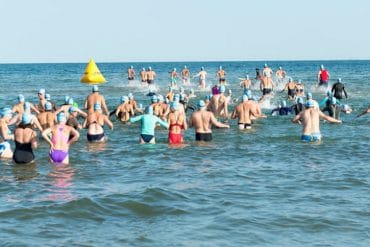Larry Silverstein is the Chairman of Silverstein Properties in New York and has been the driving force in the $20 billion redevelopment of the World Trade Center and surrounding buildings. Silverstein’s story of both dealing with the trauma after 9/11, which he narrowly escaped, along with the almost impossible challenges faced through dealing with the New York Port Authority and Insurance companies en route to rebuilding the site, is extraordinary. N Magazine interviewed him in his forty-first floor office overlooking the Ground Zero redevelopment site to discuss his connection to Nantucket and his experience both during and after the 9/11 attack.
N: Tell us about your connection to Nantucket?
Silverstein: We first came to Nantucket in 1966 when Walter Beinecke had just finished rebuilding the downtown area and the wharfs. My wife and kids felt the island was majestic. The magnificent sandy beaches, the water clarity and now the Whaling Museum are just terrific. You see the kids’ faces and eyes light up in the museum. The island is still an idyllic place for us.
N: It seems like you had two lives: one pre-9/11 and one post-9/11. Can you first talk about your world prior to the terrorist attack?
Silverstein: Thank God I married my wife, because we lived on her $3,200 salary for the first three years of marriage. We then started buying some real estate with other people’s money, and that opened the door to being able to acquire more property, better property, and larger properties. The banks, who had previously rejected us, suddenly came to us asking us what we needed. This changed our lives because it enabled us to do significantly larger projects. We built high-rise buildings, residential condos, acquired office buildings, warehouses, hotels—you name it, we’ve done it. We’ve been involved with between thirty and forty million square feet of real estate since we began, and we kept it very low profile. That went out the window with 9/11.
N: Despite the tragedy, I understand something remarkably fortuitous happened on 9/11 for you personally.
Silverstein: Yes, we acquired the World Trade Center around the 26th of July 2001, just six weeks before 9/11 occurred. I would spend my mornings at Windows on the World, having breakfast with different tenants and would generally leave by noon to go to our offices. We had already relocated half our company to space on the eighty-ninth floor of the North Tower. As it happened that morning, my wife had made a dermatology appointment for me. With fair skin and years of boating, I make frequent visits. I told my wife to cancel my appointment because I had a meeting, and she became furious with me. After you are married to the same woman for fifty years, you know when it is time to say, “I’ll go dear.” It saved my life. Had the plane hit fifteen minutes later at 9:00, half my company would have been gone as well as the lives of my two children, because they were on their way downtown. We did, however, lose four people who left six children behind.
N: Your relationship with the tragedy of 9/11 is more complex than most. What was your personal reaction?
Silverstein: When I saw the North Tower in flames and saw the South Tour hit, I knew instantly this was a major attack. It occurred to me quite quickly that this was not just an attack on the Twin Towers, but an attack on America, our values, our democracy and everything we stand for. I began to wonder what else was coming, and found myself in a depressed state for the first time in my life. I had previously served as Chairman for United Jewish Appeal, which provides a wide range of services to people to all walks of life, including counseling services. I now found myself on the receiving end of those services and it was very helpful in getting all of us refocused to determine what had to be done.
N: When did you decide you wanted to rebuild 7 World Trade Center?
Silverstein: I actually had no recollection of this, but my architect David Childs, who is the senior architect at Skidmore, Owings and Merrill, remembered my calling him and saying we need to rebuild this building right away. This particular building had the good fortune of no loss of life, and had a power substation that had to be put back in service urgently to provide electricity for lower Manhattan. We co-designed the new substation with Con Edison, which is integrated into the building, and by April 2002, we had a shovel in the ground and began to rebuild.

N: What made you rebuild at a time when many people questioned the future viability of lower Manhattan?
Silverstein: At the time we decided to rebuild, the area was still a smoldering mess, but you had to believe we could get through it. People told me I was stupid, and the insurance companies offered me a great deal of money to walk away. But, if we had left this site fallow, the terrorists would get what they want. We are both New Yorkers and Americans, and that was not going to happen. I told the insurance companies that no amount of money would change my mind, and we spent five years of litigation with twenty-two insurance companies, and spent $200 million worth of legal fees to finally get them to pay us the money so we could rebuild.
N: Now that you have taken control of the situation and not only re-built 7 World Trade Center, but the entire Ground Zero area, what are you most proud of in terms of your vision?
Silverstein: The fact that we’ve got this site to this point, where it could be rebuilt and finally gained the cooperation of the Port Authority, has been a major accomplishment. My skin is thicker but we closed our ears, charged ahead, and ultimately prevailed, which gives us an enormous amount of satisfaction. I look out the window of my office and feel blessed that Towers 3 and 4 are in the works, (Tower 2 is in the works?) and are on our way to providing a new 24/7 community with unparalleled quality for everyone in New York to enjoy.
7 World Trade Center, after intensive study as to what caused the towers to come down, was built to a new standard in this country and is also a green LEED-certified gold building. At the end of the day we will have buildings designed by world-class architects with destination retail, river access, and underground accessibility to the East Side and have created a community that will impact sixty thousand families. It will be a magnificent memorial tribute to those who lost their lives, and at the end of the day, the $20 billion will result in a project of extraordinary beauty.

N: Are you a different person than you were before 9/11?
Silverstein: My primary motivation pre-9/11 was profit, and while quality was important, building first-class buildings was not our focus. Today, that is very different and we put the profit issue aside in favor of quality, safety, and design. From a personal standpoint, I feel more fulfilled
N: You are in your eighties, has this process aged you or made you younger?
Silverstein: Things initially were very difficult and tumultuous with the insurance lawsuits, but once we got to the point that people realized that we were the good guys and started embracing us, I was so much happier. I will tell you that the last ten years have been the passion of my life.
N: What has the entire 9/11 experience taught you about America?
Silverstein: I think the experience of 9/11 brought out the best in many people, and the outpouring of help from those who didn’t have any clue as to who the firefighters or victims were…was the most beautiful thing to see. The plan to make World Trade Center bigger and better than ever showed determination, that terrorism could not succeed, and our level of resolve.







